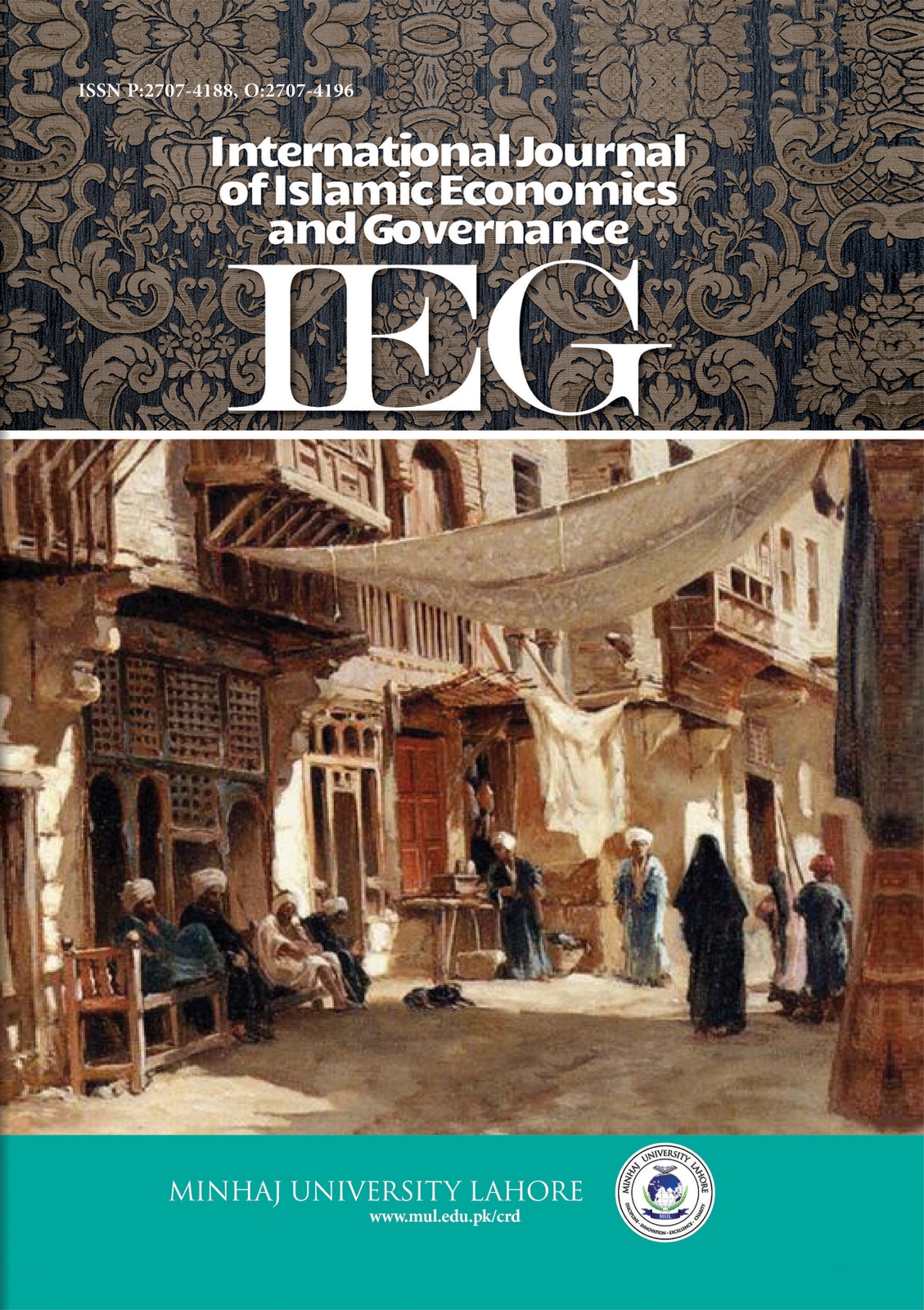Resilience of Islamic Banking in Indonesia: A VECM Analysis of Macroeconomic Shocks and Medium-Term Recovery Dynamics
DOI:
https://doi.org/10.58932/MULD0047Keywords:
Early Warning System, Islamic Banking, Monetary Crisis, Stable Financial Performance, VECMAbstract
The failure of conventional economics during the 2007/2008 crisis spurred the emergence of Islamic economic alternatives this day. Comparative studies have assessed its resilience. This research comprehensively examines Islamic banking's resilience to economic crises, addressing gaps in previous studies that focused only on specific crisis periods. Monthly data from 2015-2023 from SPS- OJK, BPS, and Monetary Statistics-BI were analyzed using VECM methods. Real GDP was found to have the most significant negative impact on various Indonesian Islamic banking performance variables. Islamic banks can, therefore, utilize an Early Warning System for real GDP. The variables affected by macroeconomic shocks show short- to medium-term dynamics, recovering from periods 3-5, and stabilizing performance. This study fills previous research gaps that indicated instability in Islamic banking by considering only short post-crisis periods. In the medium term, Islamic banking in Indonesia has proven effective in recovering from crises, as shown by the analysis of recurring economic crises.
© 2025 The Author(s). Licensed under CC BY-NC 4.0.
References
Abaidoo, R., & Agyapong, E. K. (2021). Corporate performance volatility: a micro-level perspective. Journal of Money and Business, 1(1), 42-63.
Abbey, E. N. (2012). Inflation and financial development: Evidence. American Journal of Economics and Business Administration, 4(4), 227.
Abedifar, P., Molyneux, P., & Tarazi, A. (2013). Risk in Islamic banking. Review of finance, 17(6), 2035-2096.
Adebola, S. S., Yusoff, W. S. W., & Dahalan, J. (2011). The impact of macroeconomic variables on Islamic banks financing in Malaysia. Research Journal of Finance and Accounting, 2(4), 22-32.
Afgani, K. F., Rivanda, A. K., & Purbayati, R. (2021). Predicting Corporate Bankruptcy: Based on MDA Textile and Garment on Indonesia Stock Exchange. Jurnal Ilmiah Manajemen, Ekonomi, & Akuntansi (MEA), 5(2), 1918-1932.
Ahokpossi, M. C., Isnawangsih, A., Naoaj, M. S., & Yan, T. (2020). The impact of monetary policy communication in an emerging economy: The case of Indonesia. International Monetary Fund.
Ahmad, S., Qamar, A. J., Bhatti, M. A. A., & Bashir, U. (2023). Integrating Islamic Ethics with Modern Governance: A Comprehensive Framework for Accountability Across Religious, Social, and Economic Dimensions. Al-Irfan, 8(15), 51-79.
Aikman, D., Lehnert, A., Liang, N., & Modugno, M. (2025). Credit, financial conditions, and monetary policy transmission. 62nd Issue (June 2020) of the International Journal of Central Banking.
Al-Awadhi, A. M., Alsaifi, K., Al-Awadhi, A., & Alhammadi, S. (2020). Death and contagious infectious diseases: Impact of the COVID-19 virus on stock market returns. Journal of Behavioral and Experimental Finance, 27, 100326.
Albertazzi, U., Barbiero, F., Marqués Ibáñez, D., Popov, A., D'Acri, C. R., & Vlassopoulos, T. (2020). Monetary policy and bank stability: the analytical toolbox reviewed (No. 2377). ECB working paper.
Aryati, A., Junaidi, J., & Putra, R. A. (2023). Financial Development and Economic Growth: Evidence from Indonesia Before and After the COVID-19 Pandemic. Экономика региона, 19(4), 1263-1274.
Anjum, G., & Bhatti, M. A. A. Discover the Impact of Internet Usage on the Academic Performance of Library and Information Science Students. Indonesian Journal of Multidiciplinary Research, 4(2), 377-388.
Bhatti, M. B. A., & Khan, M. K. (2024). Implications of Project Managers’ Competencies on Project Success Moderating effect of Project Risk Management: A case of IT Sector in Lahore. Pakistan Journal of Multidisciplinary Research, 5(1), 66-85.
Bacha, M., Wadood, F., & Qayyum, A. (2019). Interest rate and banks performance: A comparative analysis of Islamic and conventional banks. Indian Journal of Economics and Business, 20(3),1529-1541. url:http://www.ashwinanokha.com/IJEB.php
Bank, W. (2023). Indonesia economic prospects. Washington DC: International Bank for Reconstruction and Development/ The World Bank. url:http://www.worldbank.org/iep
Beck, T., Demirgüç-Kunt, A., & Merrouche, O. (2013). Islamic vs conventional banking: Business models, efficiency and stability. Journal of Banking and Finance, 37(2), 433-447. doi:https://doi.org/10.1016/j.jbankfin.2012.09.016
Bhatti, M. A. A., & Nazir, M. U. (2024). The Impact of Project Process Management on Sustainable Project Success in the Construction Sector: The Moderating Role of Risk Management Practices. Bulletin of Business and Economics (BBE), 13(2), 1065-1072.
Carissa, N., & Khoirudin, R. (2020). The factors affecting the rupiah exchange rate in Indonesia. Journal of Development Economics,18(1), 37-46. doi:http://dx.doi.org/10.29259/jep.v18i1.9826
Chen, H.-C., & Yeh, C.-W. (2021). Global financial crisis and covid-19: Industrial reactions. Finance Research Letters, 42(101940), 1-13. doi:http://dx.doi.org/10.1016/j.frl.2021.101940
Chowdhury, M. A., & Eskandar, M. (2016). Determinants of performance of Islamic banks in GCC countries: Dynamic GMM approach: An Asian perspective. Advances in Islamic Finance, Marketing, and Management, (pp. 49-80). Emerald Group Publishing Limited. doi:https://doi.org/10.1108/978-1-78635-899-820161005
Demirgüç-Kunt, A., Pedraza, A., & Ruiz-Ortega, C. (2021). Banking sector performance during the covid-19 crisis. Journal of Banking & Finance, 133(106305), 1-22. doi:http://dx.doi.org/10.1016/j.jbankfin.2021.106305
Elder, J. M., & Apostolos, S. (2010). The role of exchange rates in oil price fluctuations: A VECM approach. Journal of Money, Credit and Banking, 42(6), 1137-1159. doi:10.1111/j.1538-4616.2010.00323.x
European Systemic Risk Board. (2021). Financial stability implications of support measures to protect the real economy from the covid-19 pandemic. url:https://rb.gy/bxxx4t
Fakhri, U. N., & Darmawan, A. (2021). Comparison of Islamic and conventional banking financial performance during the covid-19 period. International Journal of Islamic Economics and Finance, 4(SI), 19-40. doi:https://doi.org/10.18196/ijief.v4i0.10080
Fokin, N., Malikova, E., & Polbin, A. (2024). Time-varying parameters error correction model for real ruble exchange rate and oil prices: What has changed due to capital control and sanctions. Russian Journal of Economics, 10(1), 20-33. doi:https://doi.org/10.32609/j.ruje.10.111503
Fund, I. M. (2020). Global financial stability report: Markets in the time of covid-19. Global Financial Stability Report. International Monetary Fund. url:https://rb.gy/nd5s9t
Ghosh, S. (2016). Macroprudential policy, crises and risk taking: Evidence from dual banking systems in the GCC countries. Journal of Islamic Accounting and Business Research, 7(1), 6-27. doi:10.1108/JIABR-03-2014-0011
Hafidh, A. A. (2020). Responses of Islamic banking variables to monetary policy shocks in Indonesia. Islamic Economic Studies, 28(2), 174-190. doi:https://doi.org/10.1108/IES-11-2020-0049
Harjanti, W., & Farhan, A. (2021). The effect of FDR, NPF and liquidity ratio on profitability of Islamic banks in Indonesia. Budapest International Research and Critics Institute-Journal (BIRCI-Journal), 4(4), 1-9.
Hassan, M., Rabbani, M., & Abdulla, Y. (2021). The socio-economic impact of covid-19 in the Mena region and the role of Islamic finance. International Journal of Islamic Economics and Finance, 4(1), 51-78.
Heniwati, E. (2019). Empirical study of the strength of financial stability of sharia banking in Indonesia. Journal of Business Economics and Entrepreneurship, 8(2), 147- 160. doi:http://dx.doi.org/10.26418/jebik.v8i2.28015
Bhatti, M. B. A., & Durrani, M. K. (2024). The effect of project managers’ competencies on project success with mediating role of project stakeholders’ engagement: A case of IT sector. Journal of Management Info, 11(1), 51-73.
Heniwati, E., Yantiana, N., & Desyana, G. (2021). Financial health of syariah and non- syariah banks: A comparative analysis. Journal of Islamic Accounting and Business Research, 1759(0817), 473-487. doi:10.1108/JIABR-07-2020-0216
Hossin, M. S., & Mondol, M. F. (2020). Impact of exchange rate fluctuations on financial performance of state-owned commercial banks in Bangladesh: An empirical study. Noble International Journal of Economics and Financial Research, 5(9), 92-101. url:http://napublisher.org/?ic=journals&id=2
Huynh, J. (2024). What drives bank liquidity creation? The interaction of monetary policy and strategic scope. Journal of Finance and Banking, 10(2), 15.
Huynh, T., & Uebelmesser, S. (2024). Early warning models for systemic banking crises: can political indicators improve prediction? European Journal of Political Economy, 81, 3-6. doi:https://doi.org/10.1016/j.ejpoleco.2023.102484
Jatmiko, D. S., Djatnika, D., & Setiawan. (2021). Resilience of sharia commercial banks in Indonesia against domestic macroeconomic fluctuations and federal reserve fund interest rates. Journal of Applied Islamic Economics and Finance, 1(2), 349-361. doi:https://doi.org/10.35313/jaief.v1i2.2469
Jawad, S., Naveed, H., & Akram, M. B. (2020). Academic Performance of Enrolled Students in the University of Lahore, Pakistan. Quest Journal of Management and Social Sciences, 2(2), 357-365.
Kabir, M., & Worthington, A. (2017). The competition–stability/fragility nexus: A comparative analysis of Islamic and conventional banks. International Review of Financial Analysis, 50, 111-128. doi:https://doi.org/10.1016/j.irfa.2017.02.006
Kabir, M., Worthington, A., & Gupta, R. (2015). Comparison of credit risk in Islamic and conventional banks. Pacific-Basin Finance Journal, 34, 327-353. doi:https://doi.org/10.1016/j.pacfin.2015.06.001
Kalifa, W., & Bektaş, E. (2017). The impacts of bank-specific and macroeconomic variables on the capital adequacy ratio: Evidence from Islamic banks. Applied Economics Letters, 25(7), 477-481. doi:https://doi.org/10.1080/13504851.2017.1340559
Kassim, S., Majid, S., & Yusof, R. (2009). The impact of monetary policy shocks on conventional and Islamic banks in a dual banking system: Evidence from Malaysia. Journal of Economic Cooperation and Development, 30(1), 41-58.
Keuangan, O. J. (2020). The Indonesian Financial Services Sector Master Plan 2021-2025. to Recover the National Economy and Enhance the Financial Services Sector Resiliency and Competitiveness. Indonesia Financial Services Authority (OJK): Jakarta. available on the OJK website www. ojk. go. id.
Khan, S., Aziza, N. A., & Nawaz, A. D. (2024). Islamic and conventional banks stability in Indonesia. International Journal of Financial Economics and Econometrics, 23(1), 167-182. doi:https://doi.org/10.15408/etk.v23i1.33879
Kheddiri, K., Ben, C. L., & Youssef, S. (2015). Islamic versus conventional banks in GCC countries: A comparative study using classification techniques. International Business and Finance Research, 33, 75-98. doi:https://doi.org/10.1016/j.ribaf.2014.07.002
Kismawadi, E. R. (2023). Contribution of Islamic banks and macroeconomic variables to economic growth in developing countries: Vector error correction model approach (VECM). Journal of Islamic Accounting and Business Research, 15, 5-8. doi:https://doi.org/10.1108/JIABR-03-2022-0090
Lahoue, B. B., L. T., Zaied, Y. B., & Managi, S. (2022). Financial stability, liquidity risk and income diversification: Evidence from European banks using the CAMELS– DEA approach. Annuals of Operations Research, 334, 8-9. doi:https://doi.org/10.1007/s10479-022-04805-1
Lilian, G., Blessed, M., Chosani, S., T.T, M. T., & Kudakwashe, Ba. (2022). The effect of exchange rate fluctuations on bank profitability in Zimbabwe. Global Scientific Journals, 10(2), 797-807. url:https://rb.gy/f1gue8
Maharani, E. D., & Budiman, A. (2023). The influence of macroeconomic factors on BUS profitability: Study of sharia commercial banks in Indonesia registered with the OJK for the 2018-2020 period. Al Kharaj - Journal of Sharia Economics, Finance and Business, 5(3), 1405-1418. doi:https://doi.org/10.47467/alkharaj.v5i3.1725
Mansour, M., Hashim, H. A., & Salleh, Z. (2020). Datasets for corporate governance index of Jordanian non-financial sector firms. Data in Brief, 22(30), 15. doi:https://doi.org/10.1016/j.dib.2020.105603.
Mitra, G., Gupta, V., & Gupta, G. (2023). Impact of macroeconomic factors on firm performance: Empirical evidence from India. Investment Management and Financial Innovations, 20(4), 1-12. doi:https://doi.org/10.21511/imfi.20(4).2023.01
OJK, I. F. (2022). Indonesian sharia financial development report. Jakarta: Indonesia Financial Services Authority (OJK). url:https://rb.gy/esw6qt
Pham, H. S., Le, T., & Nguyen, L. Q. (2021). Monetary policy and bank liquidity creation: Does bank size matter? International Economic Journal Taylor & Francis Group, 35(2), 205-222. doi:https://doi.org.10.1080/10168737.2021.1901762
Purbayati, R., Pakpahan, R., Juniwati, E. H., & Rivanda, A. K. (2022). Resilience of sharia banking in Indonesia against fluctuations in conditions. Indonesian Journal of Sharia Economics, 12(2), 96–107. doi:https://doi.org/10.21927/jesi.2022.12(2).95-107
Riyanti, D., & Harta, R. (2023). The role of social capital in enhancing economic resilience during the covid-19 pandemic in Bantul Regency. Jurnal Civics Media Kajian Kewarganegaraan, 20(1), 75-84. doi:http://dx.doi.org/10.21831/jc.v20i1.45052
Rafaqat, M. ., Azad, F. ., Ahmad, S. ., Aijaz, K. ., Ikram, S. H. ., Bashir, U. ., Bhatti, M. A. A. ., & Saeed, S. . (2024). Impact of Governance and Strategy Performance on Employer Branding. Research Journal for Societal Issues, 6(2), 852–867.
Salma Louati, Y. B. (2015). Banks’ stability-efficiency within dual banking system: a stochastic frontier analysis. International Journal of Islamic and Middle Eastern Finance and Management, 8(4), 472-490. doi:https://doi.org/10.1108/IMEFM-12-2014-0121
Sarwar, A., Khan, M. A., Sarwar, Z., & Khan, W. (2020). Financial development, human capital and its impact on economic growth of emerging countries. Asian Journal of Economics and Banking, 5(1), 86-100. doi:https://doi.org/10.1108/AJEB-06- 2020-0015
Singh, A., & Sharma, A. K. (2016). An empirical analysis of macroeconomic and bank- specific factors affecting liquidity of Indian banks. Future Business Journal. 2(1), 40-53. doi:https://doi.org/10.1016/j.fbj.2016.01.001
Sueb, M., Prasojo, Muhfiatun, Syarifah, L., & Putra, R. N. (2022). The effect of shariah board characteristics, risk-taking, and maqasid shariah on an Islamic bank’s performance. Banks and Bank Systems, 17(3), 89-101. doi:http://dx.doi.org/10.21511/bbs.17(3).2022.08
Windsor, C., Jokipii, T., & Bussiere, M. (2023). The impact of interest rates on bank profitability: A retrospective assessment using new cross-country bank-level data. International Banking Research Network Contributors, (5). External Communications. doi:https://doi.org/10.47688/rdp2023-05
Ye, M., Hutson, E., & Muckley, C. (2014). Exchange rate regimes and foreign exchange exposure: The case of emerging market firms. Emerging Markets Review, 21, 156-182. doi:http://.doi.org.10.1016/j.ememar.2014.09.001
Zarrouk, H. (2014). The impact of the international financial crisis on the performance of Islamic banks in Mena countries. The Developing Role of Islamic Banking and Finance: From Local to Global Perspectives Contemporary Studies in Economic and Financial Analysis, 95, 45-69. doi:https://doi.org. 10.1108/S1569-3759(2014)0000095011
Zimmermann, K. (2019). Monetary policy and bank profitability, 1870 – 2015. Leibniz Institute for Financial Research Safe (1-47). doi:https://doi/org.10.2139/ssrn.3322331
Zulkhibri, M. (2018). The impact of monetary policy on Islamic and conventional banks: Evidence from Malaysia. Journal of Economics Finance and Administrative Science, 23(46), 306-322. doi:https://doi.org/10.1108/JEFAS-01-2018-00.









